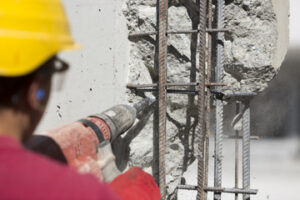Home » Posts tagged 'stamped concrete'
Tag Archives: stamped concrete
How to Properly Repair and Maintain Concrete
Concrete damage can be addressed in a variety of ways. It’s important to take safety precautions, allocate enough time for meticulous assessment and precise execution, avoid common mistakes, and practice proper maintenance to ensure the longevity of a repair.

Structural repairs involve addressing cracks that impact the structural integrity of a concrete surface. Partial-depth repairs that abut working joints or cracks require a compressible insert to reform the joint or crack and keep the repair from bearing on existing concrete. Contact Concrete Repair Bismarck for professional help.
When it comes to crack repair, a few key points need to be kept in mind. First, the crack needs to be thoroughly cleaned. This step is important because leftover debris can compromise the effectiveness of the repair and cause new cracks to form. Using a wire brush and blower can help ensure that the crack is free of loose concrete or dirt. Once the crack is clean, it’s also important to make sure that the crack filler or patching product will be able to bond well with the existing concrete. This will allow for a long-lasting and durable solution.
Cracks in concrete are more than just unsightly; they can also pose serious safety hazards. For example, larger cracks can trip people and cause injury. While smaller cracks may catch high-heel shoes and cause them to slip or fall, repairing these cracks can minimize the risks of accidents and injuries. Cracks can also create moisture problems, allowing for moisture ingress that can damage the concrete and lead to structural issues. To avoid these issues, it’s important to repair concrete cracks as soon as possible.
It’s also important to distinguish between structural and non-structural cracks. Structural cracks are much wider, deeper, and more irregular in shape than non-structural cracks and can impact the stability and integrity of a structure. These types of cracks require immediate professional assessment and can be repaired with a variety of solutions, including polyurethane resins or foam injection.
Non-structural cracks are less severe and typically a result of poor construction practices or soil settlement beneath the concrete slab. These types of cracks can be repaired with a variety of products, including epoxy, polyurethane crack fillers, and water-based polyurethane caulks.
When repairing cracks in concrete, it’s often necessary to undercut the edges of the crack to create a more narrow base for the repair material. In addition, it’s often a good idea to use a backer rod when repairing deep cracks to help the filler hold its shape and prevent sinking. In some cases, it may be necessary to reapply the crack filler when it sinks or loses its shape.
Delamination
Concrete is a strong and durable material, but it can suffer from damage and deterioration over time. Fortunately, there are solutions that can restore damaged concrete surfaces and prevent future problems.
The first step in any successful concrete repair is proper preparation. This includes cleaning the existing surface and removing any dirt, debris or contamination. It is also important to make sure that the concrete patch will adhere properly to the existing surface. This can be achieved by using the right cement, sand and admixture mixture. Finally, it is critical to allow sufficient time for curing.
If the concrete patch is not properly prepared, or if the curing process is rushed, delamination may occur. Delamination is the separation of layers of concrete, usually caused by water or air that gets trapped under the surface of the concrete. This can lead to cracking, spalling and other damage to the concrete.
When a new slab of concrete is poured, it goes through a process called “bleeding.” This is when the solids in the concrete mix displace the water and air inside them. If the troweling process is started before this process is complete, water and air will get trapped under the surface of the concrete, creating voids that can weaken and break down the concrete over time.
Concrete repair techniques can be used to address delamination, such as stitching and epoxy injections. Stitching involves drilling holes on both sides of a crack and installing large staple-looking metal units into the hole to keep the crack from expanding. Epoxy injections are a more permanent solution and involve pumping epoxy into the crack to fill it.
Another common cause of delamination is poor construction practices. This can include skipping surface preparation, using the wrong products or rushing the curing process. It is essential that the concrete repair contractor has enough experience to understand these issues and follow the correct procedures to ensure a lasting solution.
While repairing old or damaged concrete can be challenging, it is possible to achieve good results. With proper care, the repaired concrete can last for decades and provide a strong foundation for other building materials.
Loose Slabs
Concrete slabs can sink, crack, or become unstable, which causes a number of warehouse issues. Slabs that sink are often caused by sub-slab voids, which occur in the soil beneath the slab. Fortunately, there are products and procedures that can address these voids and lift the concrete back to its original position.
Cracking is a natural part of the aging process in any type of construction material. However, this can cause structural damage that affects the integrity of the structure and reduces its lifespan. The causes of cracking in concrete are many and varied, ranging from temperature extremes that cause air pockets to expand or contract and shift the concrete, to soil changes that weaken the sub-base and compact it. The best method to correct cracking is to use a crack filler that will seal the concrete and prevent further damage, such as Quik Fix from Deco-Crete Supply.
Spalling is a common issue that can affect concrete slabs, particularly those with an exposed aggregate finish. The process causes the top layer of concrete to flake and break away, exposing the aggregate underneath. Spalling is usually a cosmetic issue, but can also be a safety hazard in high-traffic areas. The most common cause of spalling is moisture infiltration, which leads to expansion and contraction of the concrete and can also corrode the steel rebars within the slab.
Repairing a spalled or gouged surface requires removing the loose concrete and then cleaning the area to remove any debris that may have accumulated. It is important to isolate the deteriorated concrete from the surrounding slab and shoulder materials using full-depth saw cuts, which minimizes any damage that may be caused to the existing materials when the deteriorating section is removed.
If you are planning to repair a damaged concrete floor, consider the benefits of a precast floor system. This will not only save time and money, but it can also minimize the amount of disruption to your operations and increase your productivity during the installation process. A good precast system will include concrete slabs that are poured at the same time as the other slabs in the same area. This will reduce the time and labor involved, as well as help to ensure that the slabs are level and aligned properly.
Joints
Concrete slabs require joints to manage expansion, contraction and ground movement. They also control cracks by directing them in predetermined directions. The location and depth of these expansion and control joints is critical to the longevity of the concrete. They are especially important in large industrial structures like warehouses and distribution centers. A hard, uninterrupted concrete floor surface increases productivity and facilitates safe material handling.
However, over time and due to heavy traffic the joints can deteriorate. This is when we start to see visible cracks around the joint and/or water infiltration at the joint. A deteriorated joint filler can lead to loss of movement capacity which will eventually cause concrete damage.
Normally, the joints are filled with wood or a soft material called felt to allow the joint to move with thermal and ground settling changes without damaging the concrete. Unfortunately, these types of materials are prone to getting caught on equipment and pulled out of the concrete joint. Additionally, they don’t withstand the wear and tear of forklift traffic on the concrete.
For this reason, a newer, more compliant joint filler is required. We use a product called Trim-A-Slab, which is made from a rubber-like material that flexes and holds itself into the gap between concrete slabs. This allows the concrete to expand and contract as needed. It’s immune to rot, moves with the slab expansion and contraction, and doesn’t trap dirt and weeds like other less flexible products.
While control and expansion joints are vital to the long-term integrity of a concrete structure, they also contribute to its aesthetics. By strategically placing these joints, contractors can control the pattern of cracks that appear in the concrete and give it a more visually appealing look.
